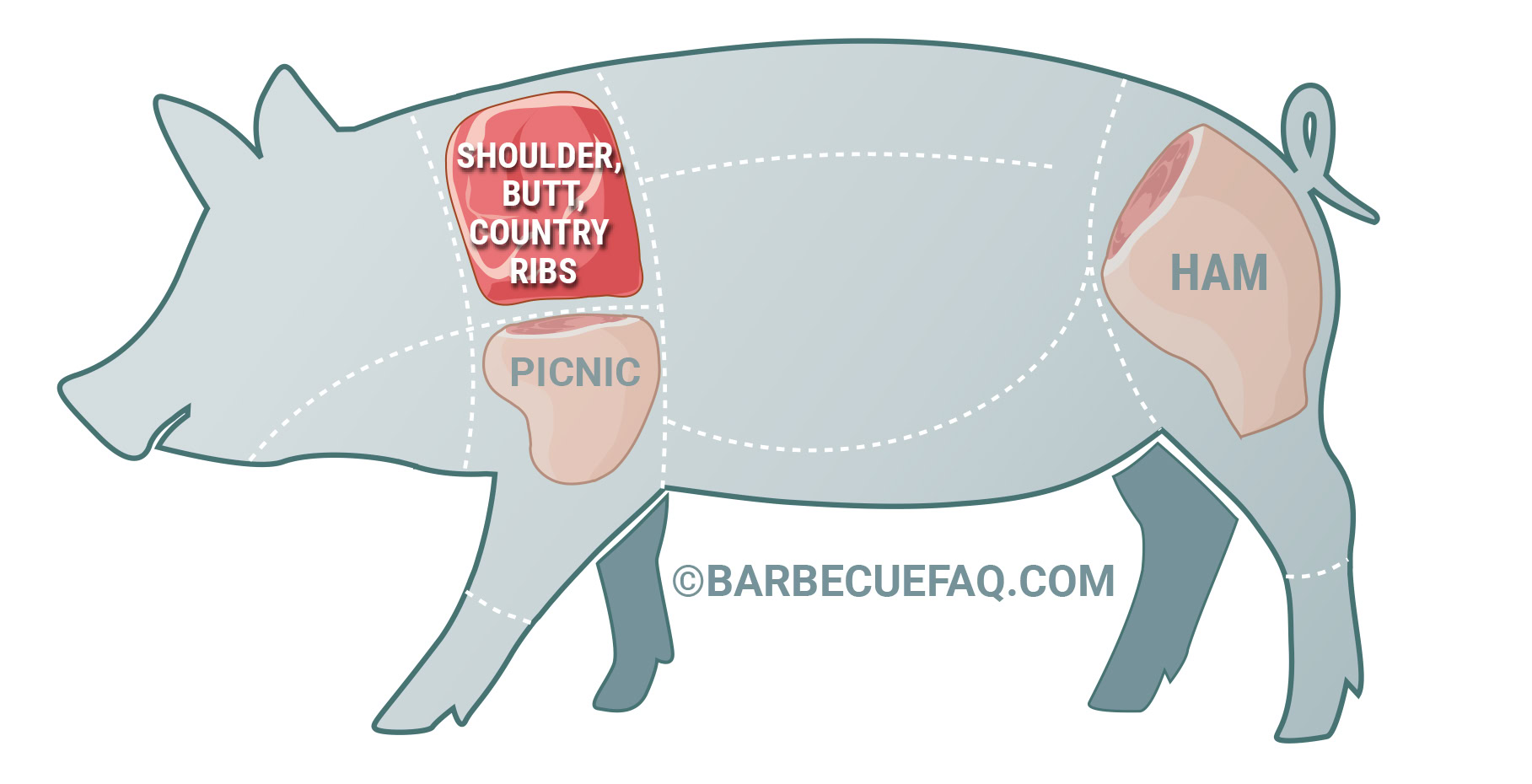Pork shoulder and Boston butt are two very similar cuts of meat that come from the front leg and shoulder of the pig. While they can often be used interchangeably in recipes, there are some subtle differences in where they are located on the pig, their fat content, and how they are best cooked.
Where They Come From on the Pig
Both Boston butt and pork shoulder come from the upper portion of the front leg of the hog. However Boston butt is cut from higher up on the foreleg closer to the pig’s shoulder blade. It contains parts of the neck, upper shoulder, and upper leg muscles.
Pork shoulder, also called picnic shoulder, comes from farther down the leg, just above the front foot It contains sections of both the leg and shoulder muscles
So while their names might suggest otherwise, Boston butt and picnic shoulder come from overlapping sections of the pig’s shoulder region. Boston butt originates closer to the shoulder joint while pork shoulder extends closer to the front leg.
Fat Content and Texture
The higher cut of meat from Boston butt contains more marbling and fat running through it compared to pork shoulder. The extra fat keeps Boston butt moist during cooking and provides rich flavor.
Pork shoulder has less internal fat. However, it is often sold with some skin and fat left on the outer surface. When purchasing pork shoulder, the fat cap can be left on or removed according to personal preference.
Because of its greater marbling, Boston butt has a looser texture compared to the denser, tighter grain of pork shoulder.
Cooking Methods
Both Boston butt and pork shoulder benefit from moist cooking methods that gently break down the connective tissues. They can be used interchangeably in recipes calling for:
- Slow roasting
- Braising
- Stewing
- Slow cooker or pressure cooking
However, their differing fat and moisture levels means that slight adjustments may be needed to achieve the best results.
Boston Butt
The high fat content of Boston butt keeps it tender. Take care not to overcook it since the meat can become dry. Cook low and slow until extremely tender.
Boston butt’s texture makes it ideal for pulled pork and carnitas. It shreds easily into delicate, juicy strands.
Pork Shoulder
The leaner pork shoulder may require extra moisture when cooking. Consider barding with fat or adding braising liquid.
Pork shoulder’s firmer texture allows it to hold up to shredding or chopping. It can be used in place of Boston butt for pulled pork, but the result will have a bit more chew.
Pork shoulder also takes well to slicing, especially when the skin and fat cap are left on. The fat bastes the meat and keeps it moist.
Cost and Availability
Boston butt and pork shoulder come from heavily exercised muscles, so they are among the cheaper pork cuts. Boston butt is very common while pork shoulder may take some searching to find in some markets.
Pork shoulder is sometimes referred to interchangeably as picnic shoulder, picnic roast, or picnic ham. Be sure to check the label closely when substituting.
The Takeaway
While Boston butt and pork shoulder can often stand in for one another, their differences in fat, texture and optimal cooking methods are worth noting. Here are some key points to remember:
- Boston butt contains more internal fat, keeping it tender and moist.
- Pork shoulder has a tighter grain and benefits from added moisture.
- Boston butt excels at pulling and shredding.
- Pork shoulder can be sliced or chopped after cooking.
- Both cuts deserve long, slow cooking times to reach peak tenderness.
So consider the specifics of your recipe when deciding whether to use Boston butt or pork shoulder. Both have wonderful pork flavor, but their uniqueness means they each shine in certain dishes.

Pork Butt vs Pork Shoulder – Ace Hardware
FAQ
What is the best cut of pork for pulled pork?
What is pork shoulder best for?
What is pork shoulder called in a grocery store?
What is the best cut of pork?
Is a pork shoulder the same as a Boston butt?
These two cuts of pork are cut from the same part of the pig, but they’re not exactly alike. Pork shoulder is leaner and has more fat than Boston butt on average, so it’ll have a slightly different flavor depending on how you prepare it.
Why is the pork shoulder called Boston butt?
The “Boston butt” is a cut of pork that is traditionally slow-cooked to create moist, tender meat. The name comes from the Boston area’s long tradition of butchering hogs. It’s possible that some of the links in this article are affiliate links. If you make a purchase after clicking on an affiliate link, I may get a commission.
How long does it take to cook Boston butt?
Slightly oil the grates of the grill. And cook the Boston butt on indirect flame and keep the temperature at 225 degrees F consistently. It may take you about 5 hours and 30 minutes to cook it on the grill.
